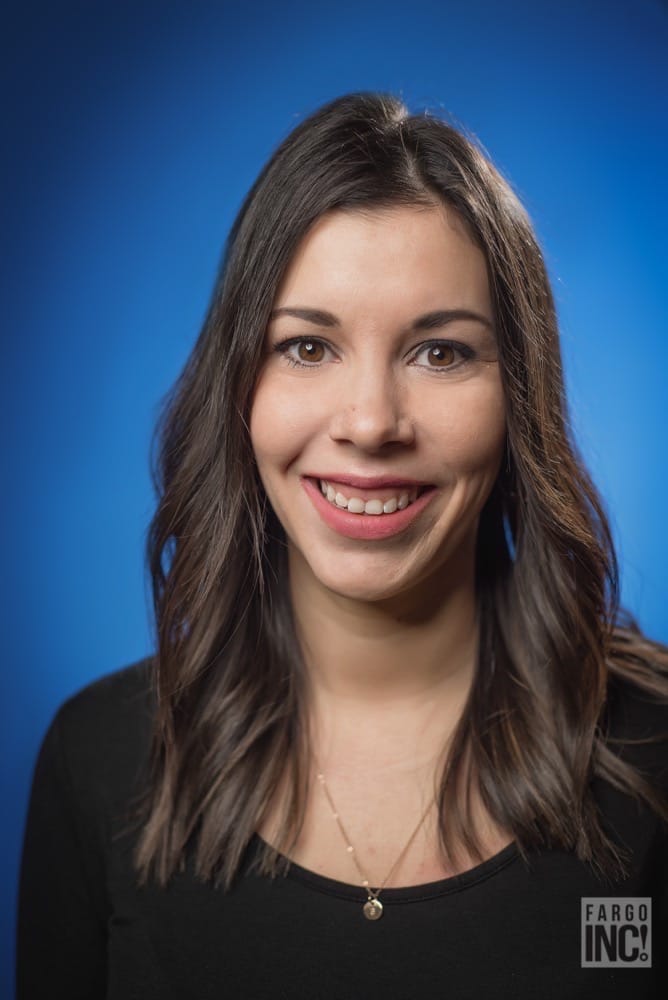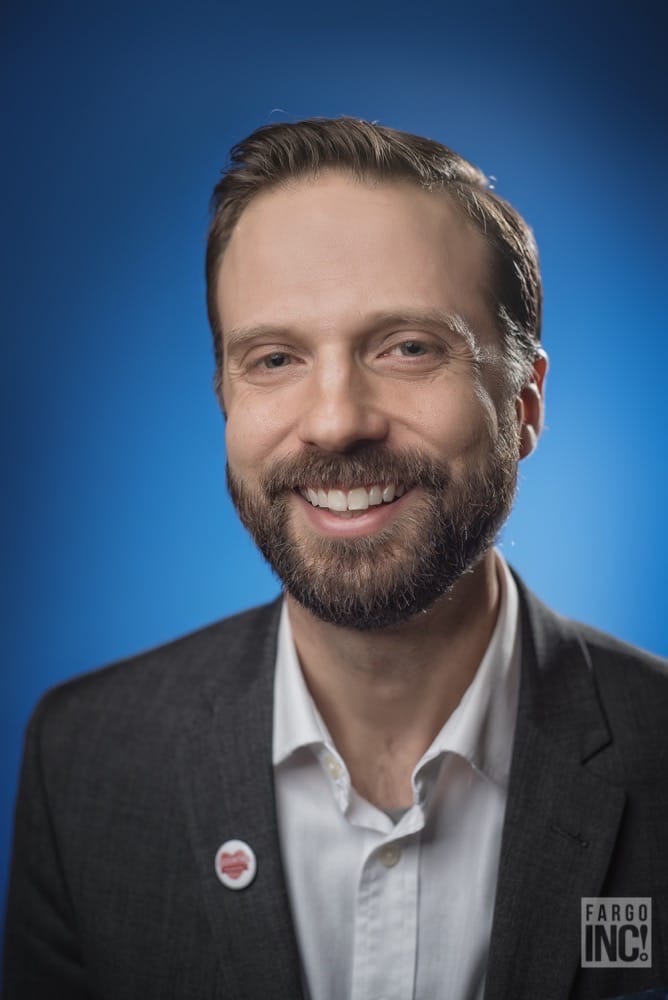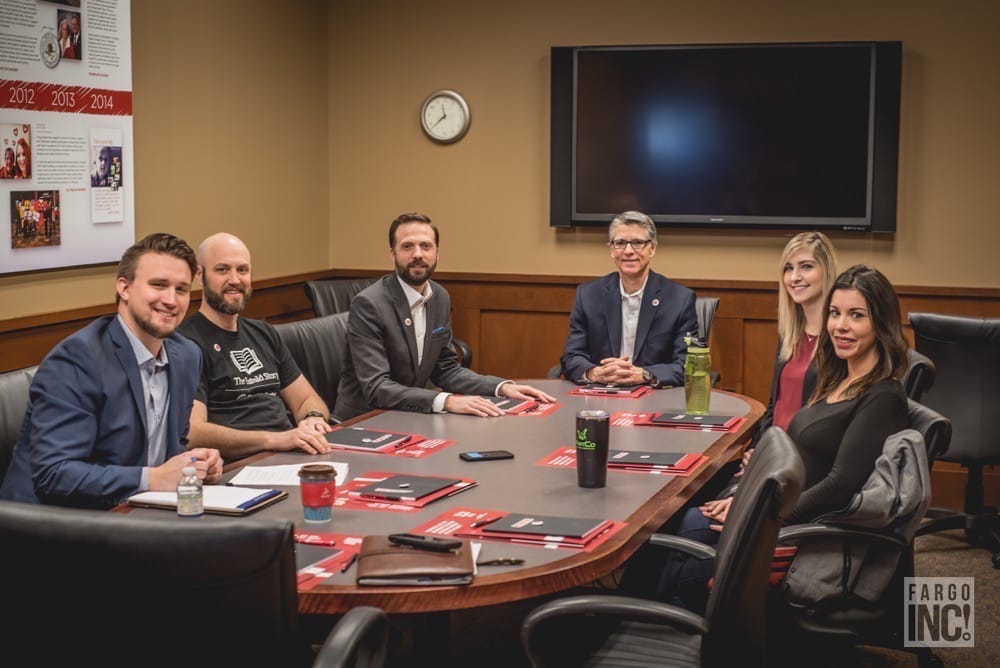A Conversation w/ New Life Center’s Rob Swier, CHARISM’s Brittany LaForte, Gate City Bank’s Amanda Torok, Impact Foundation’s Scott Holdman, Dakota Medical Foundation’s Pat Traynor
Businesses with a give-back culture have higher morale in the workplace, have more than 20 percent higher profitability and are 70 percent more likely to be viewed favorably by the community. We sat down with five local business and nonprofit leaders to talk about why giving is not only good for employees and the community, it’s good for the bottom line.

I’m a decision-maker at a business and I’m skeptical about giving to charity. Sell me on why it’s important.
Amanda Torok: Our community is what makes us thrive as a business. We wouldn’t exist if we didn’t have our community members investing in us or using us as a business, so it’s important that we give back to them. It’s also a way of us saying thank you for them using our services.
Bigger picture, though, we want our community to grow and thrive, so it’s really important that we invest back into our community members: individuals, charities and other businesses.
Pat Traynor: Businesses that have a give-back culture are more profitable and they become employers of choice. Also, when you have employees who are part of a business that has a purpose beyond itself, they’re more engaged and more productive.
The studies show that employee absenteeism goes down because the atmosphere of the employer is one of beyond just making a profit. And when you’re a profitable company, you can do more good for others. Then, that cycle comes (full circle) because customers are drawn to your business and are more loyal.
Rob Swiers: Businesses may say, “We’re all about the community,” but you can tell the organizations that mean it and those where it’s just marketing. I want to do business with places that are generous and have a positive presence in the community.
It’s like going to buy a stereo. You can tell which guy knows what he’s talking about and which one is just trying to sell you something. The one who knows what he’s talking about will sometimes say, “You know, maybe this isn’t the right one for you.” I start to trust them when I see that they’re genuine. And someone who invests in their community has to be genuine.
Brittany LaForte: It’s all about creating connections — aligning values and creating meaningful relationships that provide a stronger sense of belonging in the community and in the business itself.

Brittany LaForte, Operations Director, CHARISM
A. Torok: When your employees get involved, it gives them that sense of purpose that Pat mentioned but also fulfillment in what they’re doing. They’re showing up to work every day not just to do their job; they also know that by being there, they’re being encouraged to get active in the community and give back.
On top of that, it’s giving them that satisfaction of: I’m not only doing my job; I’m also making a difference today. And when they can see that firsthand, they’re much more excited about what they do with that business and with their community as a whole.
P. Traynor: Scott, give me the health benefits of giving.
Scott Holdman: In terms of visiting with a business owner, I think there are three distinct reasons why this is really important:
- It’s good for you.
- It’s good for your team.
- It’s good for your business.
It’s good for you because giving is good for us. One of the top five ways to lower depression is to connect as a community and give. When people volunteer, they become happier. When somebody gives a gift, the same mesolimbic pathway that lights up with pleasure when you eat a Snickers bar is associated with when you give a gift. We’re actually hardwired for giving.
Second is for your team. Participating in something like Giving Hearts Day is an incredibly powerful way for us to connect and be together. We spend more time at work (than anywhere else), so if you’re not thinking about what your employees are feeling and their view of the world — in terms of their engagement level at work — satisfaction will go down.
One of the things you can do to drive greater engagement is to insert positivity. And what brings positivity? You might think, “How about a party?” Instead, how about showing and demonstrating the difference that you make in the community for others? A small amount goes a long way.
The third is that it’s good for the bottom line. If your employees are happier and more engaged — even (setting aside) those two other points — it’s going to drive more productivity inside your business.
When we’re talking about contributing and connecting, we now have something that everyone wants but is hard to define: culture. And so to build on what Rob was saying: When you give in the community, that’s a reflection of your brand. It’s incredibly powerful for your bottom line because now your reflection into the community is that you are a business that cares. And with the consumer, given a choice between money and meaning — even though we think money is at the center — meaning is what drives us.

Scott Holdman, Director, Impact Foundation
R. Swiers: In his book “The Advantage,” Patrick Lencioni talks about how the advantage is not smarter people or better product; the advantage is the culture you create within your organization. Whatever that culture is, that’s the advantage we can have because we can control that. We can’t necessarily control those other factors, but our culture is what we can define and shape.
If I work at a company that doesn’t currently have a culture of giving but I want to help create one, what should I do?
S. Holdman: Giving Hearts Day. It has a deadline, it has a date and it’s not overwhelming. There are several things you can do to participate. A very simple one is to host a greet-and-give, where you feature a way to recognize that there are great charities (in the region) and provide your team members an opportunity to give.
You can serve refreshments, you can run contests. There are all sorts of things you can do. And you can reflect afterward to see how your team felt about the experience, see how much value it added and you can adjust moving forward.
A. Torok: Your first step could just be letting your team members know that you support Giving Hearts Day and that you’re encouraging them. It’s okay to take 15 minutes out of your day to log on to the website and donate. You don’t have to worry about somebody walking by your computer screen and see you’re not doing work.
Then, the next step is encouraging employees to get more involved. It could start with a committee or a group that comes up with ideas on how to be more involved, and then slowly over time, you’ll get more and more buy-in, and more and more employees will feel empowered to speak up. And before you know it, your culture is growing and becoming contagious within your organization. And you’ll have more and more people on board wanting to give not just on one day but throughout the year — and in a variety of ways.
R. Swiers: I think the key is getting people to take a small step into something. Because people want to be involved and want to help, but there are just so many things (out there) that are good that people can just freeze up. And if you can get into something small, then you can say, “Okay, I gave to X, Y and Z. Now, maybe I can go over and serve a meal.”
If you do something small, it sparks something that turns into something bigger, but you have to start small. You can’t start with a big shebang because it will just fall flat. Start small and just do something. Everyone can do something.
P. Traynor: There are multiple ways to engage. The nice thing about Giving Hearts Day, in particular, is that it allows for creativity and connection in a way that’s most appropriate for the organization itself. If it’s a business, there may be someone who already has meaning with a particular charity, so Giving Hearts may be a way for them to be a champion and a way for the rest of the team to celebrate one of their coworkers.
You could also just be a Giving Hearts Day champion, celebrating all the giving hearts in the region and all the donors and charities that do great work. Or you can engage on a deeper level and say, “I’m a champion for the homeless” or “I’m a champion for physical fitness for kids” or “I’m an advocate for children and adults with special needs.” That can bring out the best in a whole team because they can unite around one person’s cause, and it can become infectious.

Pat Traynor, Executive Director, Dakota Medical Foundation
A. Torok: Another reason Giving Hearts Day is such a great starting point, too, is that it’s not just about monetary donations. There are a lot of people out there who can’t give financially and that’s okay. It can be volunteering, it can be advocacy, it can be whatever helps you give back to those charities and to the community.
B. LaForte: Speaking from a personal perspective and someone not originally from Fargo, I moved down here just before Giving Hearts Day and that was a way for me to learn about the community and all the wonderful charities in the area. I got to see some of the challenges and some of the great work being done to better the lives of everyone we share this community with.
I think it helps you take that next step. For a lot of people, they would like to volunteer but might not have the time or don’t want to go alone. They can take the next step in coming together as a team to, for example, do a volunteer team-building day. And that way you learn a little more about the community you’re serving.
R. Swiers: One of the things I talk to our team about a lot is how everyone wants to follow and root for the team that’s winning. And when you have coworkers and you, as coworkers, go and do something together, you know you’re making a difference. You see the good work that so many places are doing, and all of a sudden it’s not this sea of nonprofits, it’s CHARISM, it’s New Life Center, it’s whatever. Then, you realize: This is a winning team. I think we could get involved in this.
Positivity and negativity are both contagious. As a team, if you are involved and invested and adopt a particular cause or charity, that’s positivity. And it spreads.
At many businesses — particularly larger ones — the volume of giving requests can probably get overwhelming. How can a business go about finding the right partner(s)?
A. Torok: We have a philanthropic giving committee, so it’s not one person making the decision when those requests come, but rather it’s a group. And they’re from all different areas of the bank — corporate and retail — and they’re from different locations as well, so it’s not one person in Fargo making a decision across the entire bank. I think that’s really positive, as you get a lot of feedback and a lot of insight from different individuals.
One big thing for any business to look at when they’re looking to partner with charities — or vice versa when a charity is looking for a business partner — is that it comes down to mission and values. If the mission of a charity doesn’t align with the mission of a business, it’s not going to be a great partnership. When you can find a situation where your missions align, though, you can double your impact because you’re working toward the same goal.
And it’s not just about giving money. We can do more than that. It’s about volunteering, spending time with them, and going over there and helping them with any little need they might have. There’s one organization we partner with that will reach out to us and say, “Hey, we have some people coming to the shelter. We need some Gate City blue bags.” It’s about serving on multiple levels when you make that partnership.
S. Holdman: One question to ask yourself is: What reflects our business values in the community? (Ultimately), a gift is putting your business values into action. That’s what a contribution is.
The other question to ask is: What have we been impacted by that we may want to reciprocate? With that, asking your team might be a great place to start. You may learn that someone has adopted pets that were saved, or you may learn that someone has suffered a medical catastrophe and received services, or you might find out that someone’s uncle is homeless. These kinds of things come up, and it’s a great place to talk and align how you might make a difference.
B. LaForte: It’s also about looking at what your team wants out of it because it’s a two-way street. Is it better team cohesion? Is it employee engagement? Is it positive perception?
P. Traynor: Yes, it’s about: How can we use more than just dollars to engage our employees and make a giant difference in something? You could fill in that blank with anything. If you’re a homebuilder, it could be in the lives of the homeless. Connect it to the line of industry that a business might be in and how they’re thinking strategically about their time and talent, not just their treasure.
How do businesses and charities go about figuring out what level of involvement the other is looking for?
R. Swiers: We don’t try to figure it out. We try to offer a menu, meaning: Yes, we need folks and businesses that can write checks, but we also need people. And if the culture of the business is, “We’re kind of hands off, but we do have a philanthropic wing,” praise God; that’s awesome.
“Is there a way for our employees to get involved?”
“Absolutely. Here’s an easy, low-barrier way.”
I do that with donors as well, set the table. Because trying to pigeonhole someone in never works.
B. LaForte: Yep. Making it a friendship and communicating that we’re in it together is how we go about things.
R. Swiers: And it doesn’t happen at arm’s length. Yes, you have to connect with people, but if I can get someone from a business to come to the mission, that person becomes a champion and they then have the “giver’s glow” and can spread it.
For us, it’s so important to just get people into our walls or get them involved somehow. And it doesn’t have to be a big thing. It can be one person who makes a huge difference.
A. Torok: I really enjoy having those conversations with charities when we get to meet with them. It really is a good idea to offer that table of options because then you get to feel what different businesses are looking for. For us, that’s usually where it stems into a conversation because we definitely are looking for more than just the check-writing. We also want in-kind donations — the physical items — and we want the volunteering.
R. Swiers: We tend to think of a business as an entity, but a business is a group of people. If I’m visiting with a donor, I need to have options because I may think X or Y and I may be so far off.
A. Torok: What I find so rewarding is what happens after we have people go out and volunteer. They come back, and it’s like this light has been shone in their life — that, “Wow, I didn’t know we had people going through that in our community this holiday season.”
And now you’ve created a champion. And now maybe that person has found a charity they want to connect with, to move forward with personally but also on a deeper level with their team. We also have a lot of team outings where, rather than just going bowling or having a meeting, they look at a volunteer opportunity to do together as a team to build that collaboration among each other.

Amanda Torok, Culture & Engagement Officer, Gate City Bank
S. Holdman: All of these charities are very accustomed to sharing their story, so if a business is reluctant or would like to know more or is just unsure about which one to support, reach out to the charities. The bottom line is: Involve the charities. Ask them to come and present, share some of your thoughts or just tell them you’d like to learn more. Or go and visit a few of them. It will be transformational just to go and see the amount of work they’re doing.
P. Traynor: That’s a really good strategy to start. Bring in a lunch-and-learn from time to time, and try it once a month. We think we live in the most generous place on the planet, but people need to see the good work that (charities) are doing. People simply need to be asked to be involved.
80 percent of giving in America is done by individuals, so even if the business can’t give — because, honestly, a business can’t give to every group — merely exposing your staff to a lunch-and-learn can ignite some sparks.
What you’re doing as a business is you’re opening up hearts just by listening to the charities and having these sorts of awareness activities. People don’t know everything going on in the community. They have to be asked but they have to be aware first.
B. LaForte: It’s the same for the nonprofit side, too. It allows us to learn more about different businesses.
R. Swiers: Again, nonprofits are made up of people, and as an employee in a nonprofit, I want to do business with folks who want to come and support the mission. So I’m a consumer as well. It goes both ways.
P. Traynor: You as a charity are giving a gift to someone to be a part of something bigger than themselves. So when a charity goes out and provides an opportunity for people to be involved, it’s really the expression of love and care for what it is these people are caring for. And then you become a part of that. You aren’t just a transaction.
Part of a charity’s training is that it’s not about the charity’s need to have; it’s about the individual’s need to care for others. So it goes from the individual to the organizational level, and that becomes quite a meaningful experience for both.
What are some ways a business can measure giving efforts beyond financial ROI?
R. Swiers: We have a guy — early 40s, retired military — who’s at the mission 40-plus hours a week. The fact that there are people like that out there was just not on my radar, and it blew me away. He changed my perception. He said to me, “You know what, Rob? There are other people like me in the community.” And I was like, “Yeah, okay, John.”
Well, guess what? He proved me wrong. Just this morning, he brought in someone else (to volunteer). So I no longer think that’s just an anomaly. There are people in our community who want to be involved, but they need to be asked.
P. Traynor: What’s the stat, Scott, on the volunteers who give? It’s almost all of them, right?
S. Holdman: I don’t remember the exact number, but yes, giving goes up exponentially once somebody volunteers. And that’s both volunteering — regardless of the action —or serving on a board.
For a business owner trying to quantify the impact or trying to quantify whether it was valuable for them to participate (in a giving activity), it could be something as simple as a survey afterward and a debriefing with your team to see what kind of experience they had. If they rank it as joyful and engaging and said they felt better and more connected as a team, that’s something you can quantify and say: That was worth our time and activity.
The other bucket they can measure, though, is: What did it do for our community? If I’m going to get involved in something, I want to move some needles. And every single one of these organizations that are participating in Giving Hearts Day have a mission, and you’ll be able to know what needles are moved by simply asking.
If you raised $10,000 and you call Rob and say, “I’ve raised $10,000 at my business. What’s that going to do for you guys?” Rob can tell you, “There will be X number of people who won’t be sleeping on the street tonight; you’re going to help us provide three meals today; and it’s going to help to empower, educate and assist people with gaining a brighter outlook on life.
R. Swiers: It’s systems theory at work. When someone raises $10,000, they’ve done something with their team and they’ve done something for us. I, in turn, am going to get on social media and say, “Hey, company XYZ did this. These guys are awesome.” People in the community-at-large see that, and it generates good will toward that business. It’s absolutely the system of community at work.

Rob Swiers, Executive Director, New Life Center
B. LaForte: We have quantitative impacts and qualitative impacts. So you can look at the numbers and say, “This donation or this amount of time volunteered provided this many kids with safe after-school programs, but then the qualitative is the stories behind that — it’s the more personal side: “This kid didn’t have a place to go after school and now they’re engaged.”
S. Holdman: In order to lead to any sort of action, there has to be an emotional (response). If there are facts involved, that’s good — we need both by the way — but until we feel it in our hearts, it’s hard to move toward an action. We’re competing with a lot of things trying to get our attention.
A. Torok: One way we measure is just through feedback from our employees. It might be from the culture we’ve created, but people aren’t afraid to tell us what they think. After events, they reach out and let us know how it impacted and how it opened their eyes and touched them.
Another way we measure success is when our team members aren’t afraid to make their own decisions about how they want to give back. In November, one of our offices decided they were going to do No-Shave November, and they collected donations every day and were able to surprise New Life Center with razors and shaving cream. And they were empowered to do that because they felt it in their heart. One employee had a connection with New Life Center, and they ran with an idea.
Our employees are encouraged to volunteer on company time – they don’t have to take PTO to do it — and it’s unlimited. Whether it’s 10 hours or 100 hours per year, whatever they want, they can do. And we track those hours. I can provide to our board of directors that, in 2016, we volunteered 12,700 hours. On average, that’s 22 hours of volunteering per employee. And that’s because we track it, and our culture is encouraging them to do it. Measuring that volunteer time can put a dollar amount to it.
P. Traynor: I think people underestimate what they do for others. We know how much we monetarily give, but how do you define volunteerism? Is it all through a business? I would say no.
Life doesn’t stop between work and home. If you have engaged employees, they’re not just engaged at work.
R. Swiers: And for a business, all of these things hopefully trickle down to more-satisfied employees. And satisfied employees work harder and stay longer.
If I’m a business and I want my dollar make the biggest impact possible, how do I decide between partnering with a large or a small charity?
S. Holdman: You make decisions based on your values. Small gifts are given on an organization’s need to have, and major gifts are given on a donor’s need to give. It’s up to the donor to decide that.
As professionals working in this field, we would say to be open-minded to the impact that each of these organizations are making, regardless of size. But a business must discern what their values are. Maybe it’s more important for them to support the smaller guy on the way up, and maybe it’s more important to sustain and grow a larger organization with greater impact.
R. Swiers: I think people sometimes get hung up on the percentage (of a gift) that goes to administrative, and it’s dangerous. Everyone wants such low administrative, but what people don’t realize is that even though that sounds great, if you don’t have people running the business side — you can’t have everyone just doing direct service. If that rate gets too low, the organization is probably not being run well.

P. Traynor: There’s this Puritan idea we have that we should give to the charity with the lowest administrative, but really, you, as a donor and as a business, have to connect and be fulfilled with what it is you want to support.
I would spend my time thinking, “What kinds of things am I interested in connecting with?” And then, “How can I — as an ultimate goal — have the greatest impact possible?” The most important lens is: What is the impact (a given organization) is producing today, and how could I help them have an exponentially greater impact?
Invite them in, visit with them, compare the difference. You can size it up in about 15 minutes whether they have energy, a great strategy and a vision for the future that’s palpable. Is it administrative costs you’re after or is it impact? I’ll tell you it takes a lot of administrative to produce great impact.
S. Holdman: One thing I’d say is: Don’t be scared of overhead. Because the better the people, the better the resources, the bigger the impact. Use overhead as a primary tool to judge what an organization is doing, and then consider what you want to give to.
R. Swiers: If it’s a factor, it should be one of the factors, not the factor.
We have a couple of unique generations coming into giving age: Millennials and Generation Z. How do we start thinking about engaging them more?
A. Torok: As I talk with our employees — whether it’s Gen. Z-ers or younger Millennials — a lot of them don’t have money to give and that’s okay. You can do a lot through just being that advocate we’ve talked about, that champion with your voice. You can do a lot by just connecting with a charity and asking, “I’m here. How can I help you? What can I do for you?”
So that’s one big way I think, especially looking at it beyond the monetary part of it. But I also think, too, it’s how you offer those opportunities. For example, with Giving Hearts Day, it’s online, it’s mobile, I can do it on my iPad or desktop. It’s about allowing different generations to all be able to easily connect.
S. Holdman: Trends we’re seeing are that experience really matters for younger generations. Because they’re so active on digital, we make the mistake of assuming that that’s the way they’re experiencing life, but that’s just the way they’re capturing and sharing it.
So experience is really big, particularly because they’ve grown up thinking and connecting and working in a different way. With them, it’s about framing it in terms of experience and that Giving Hearts Day should be: Here are all the things you’re going to see and participate in and you can go on tours at all these organizations. You want to create tangible experiences of involvement to connect with each other, and the community is one way to really drive them.
Another thing with younger generations is that we are seeing a more narrow focus of giving. They’re giving to one to three charities versus six or more. They’re a little bit more intentional in their giving.

P. Traynor: I would challenge them that government is not going to have the resources it’s had. It’s overspent; we can tell just by our deficits and our debt. I would challenge them to be involved and use their energy and entrepreneurship to really be social entrepreneurs.
Money isn’t necessarily the answer. It’s their ingenuity, their creative spirit, their ability to get things done and their ability to communicate in channels we didn’t have. It will be a very exciting time because we’ll realize that some of these things we’ve tried haven’t really worked, and the younger generations can say, “Maybe we have a better way to do this.” They can solve a lot of challenges because they’re going to have to.
A. Torok: As a business — knowing that they’re more focused in their giving — we should provide or help them find that focus if they don’t know where to start. If they are focused on their favorite nonprofits, maybe we can help them give back even further using the business’s donation to give to their charity of focus.
B. LaForte: For us, we’ve had a lot of parents ask if they can bring their children to come volunteer. That creates a spark, and it’s the same thing with the kids who have gone through our program. They come back, they help out, and they do tutoring because they were in that seat before and so they know what it’s like. And that is where the magic happens for us. For the kids, that relationship and having that positive role model in the community is so amazing.
A. Torok: We have the same thing, where our employees are asking to bring their kids along to volunteer and we say, “Yes, of course.”
R. Swiers: From the nonprofit’s perspective, that’s really the long-term vision. By including people who have families, those little kids are going to grow up, and it becomes a way of life for them. They will continue to invest in their community and they become better citizens.
S. Holdman: I read an interesting article about how younger generations don’t follow titles anymore, they follow influence. So part of what your culture has to do is shift into this new way of doing business, where it has to think beyond just the walls of work.
This is why Giving Hearts Day is such a great opportunity for businesses is because it’s got two things that work for all generations that are incredibly impactful:
- It has urgency — there’s a (dedicated) day. We’re all working up to the day.
- It has convenience. It’s so easy to give a gift; it’s so easy to share what I’m giving; and it’s so easy to set up contests, games, support, conversations and engagement around it. You put that all together and you get an experience that can be transformational if the spirit is right.
P. Traynor: The only thing I’d add is that it also has choice. It has urgency and convenience, yes, but all these choices reflect different circumstances of people because people usually give to what they’re connected with.
I’ll leave you with this: Imagine if every business was engaged in purpose and meaning and engaging their employees in purposeful, meaningful, giving types of programs. Imagine what our community would be like if every business were that beacon of light. We’d be addressing so many more things because people would be aware and they’d be inspired to get involved in something more meaningful than themselves.








